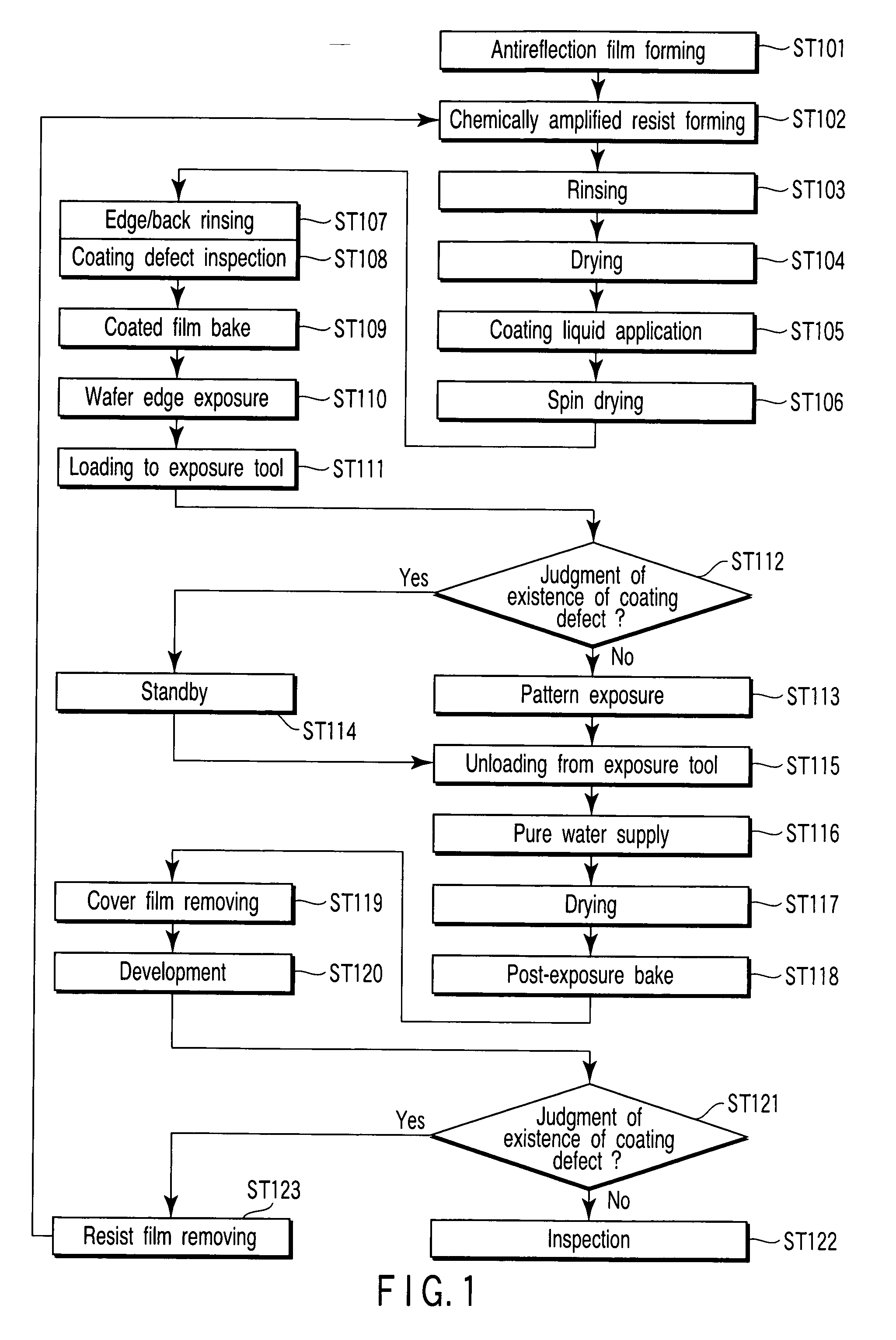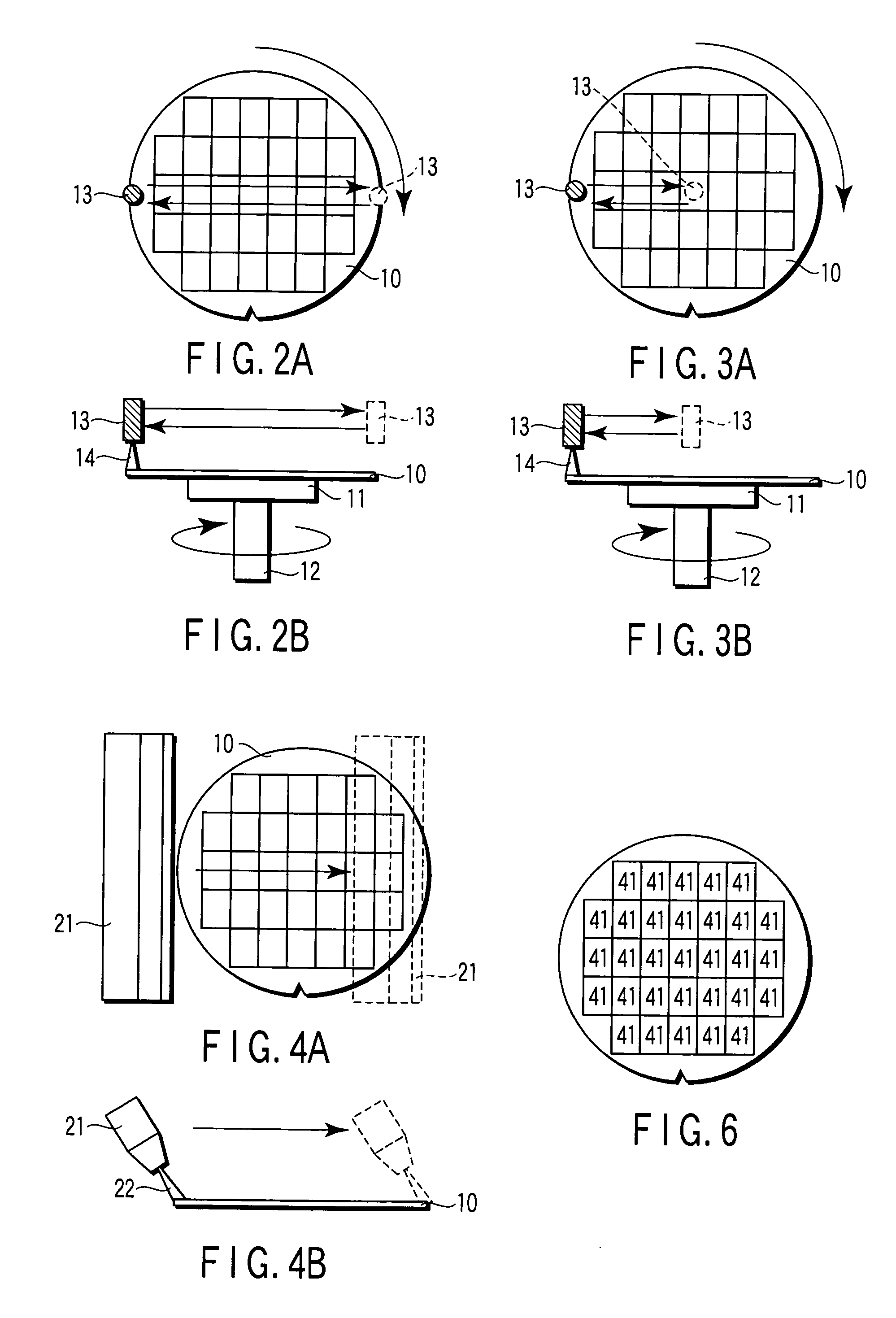Pattern forming method and method of manufacturing semiconductor device
a technology of semiconductor devices and forming methods, which is applied in the direction of originals for photomechanical treatment, instruments, photomechanical equipment, etc., can solve the problems of affecting the imaging performance, the optical path length, and the aberration of a projected image, so as to achieve the effect of avoiding the effect of affecting the operation of tools
- Summary
- Abstract
- Description
- Claims
- Application Information
AI Technical Summary
Problems solved by technology
Method used
Image
Examples
first embodiment
[0058]FIG. 1 shows a flowchart to explain a pattern forming method of a semiconductor device according to a first embodiment of the present invention.
[0059] First, a bottom-layer antireflection film is formed on a semiconductor substrate. In the present embodiment, for example, a coating-type bottom-layer antireflection film is formed (step ST101).
[0060] Then, a chemically amplified positive resist film is formed on the antireflection film (step ST102). In forming the resist film, the resist film at the edge of a wafer is selectively removed.
[0061] In a separately conducted surface analysis of some ArF chemically amplified resist films, it has been proved that photo-acid generators and acid trap agents (such as amine) are distributed on the film surface. In order to remove the photo-acid generators and the acid trap agents on the resist film surface, pure water is supplied to the resist for rinsing (step ST103). This rinsing removes the photo-acid generators and the acid trap age...
second embodiment
[0110] In the present embodiment, an example will be described in which a coating defect inspection is conducted after a substrate is loaded to an exposure tool.
[0111]FIG. 13 is a flowchart to explain a method of forming a resist pattern according to the second embodiment of the present invention.
[0112] As in the first embodiment, processing from step ST201 to step ST206 is similar to that from step ST101 to step ST110 described in the first embodiment referring to FIG. 1, and therefore duplicated explanation is omitted.
[0113] Then, the substrate is loaded to the exposure tool (step ST207). In recent years, a twin-stage type exposure tool equipped with two stages to hold the substrate has appeared. The exposure tool used in the present embodiment is schematically described referring to FIG. 14. FIG. 14 is a diagram schematically showing the exposure tool according to the second embodiment of the present invention.
[0114] The twin-stage type exposure tool comprises first and secon...
third embodiment
[0125]FIG. 15 is a flowchart to explain a manufacturing process of a semiconductor device according to a third embodiment of the present invention.
[0126] First, an antireflection film is formed on a semiconductor substrate. In the present embodiment, for example, a coating-type antireflection film is formed (step ST301). Then, a chemically amplified positive resist film is formed on the antireflection film (step ST302). A cover film is formed on the resist film (step ST303). Wafer edge exposure is conducted (step ST304). The wafer is loaded to an immersion lithography scan and repeat type exposure tool (step ST305). After various alignments are made, a semiconductor device pattern is transferred by immersion lithography to form a latent image in the resist film (step ST306).
[0127] Then, an inspection is conducted to know whether or not a liquid immersion fluid used during the immersion lithography remains on the cover film (step ST307). As detection mechanisms of the residual liqu...
PUM
| Property | Measurement | Unit |
|---|---|---|
| refractive index | aaaaa | aaaaa |
| shrinkage | aaaaa | aaaaa |
| refractive index | aaaaa | aaaaa |
Abstract
Description
Claims
Application Information
 Login to view more
Login to view more - R&D Engineer
- R&D Manager
- IP Professional
- Industry Leading Data Capabilities
- Powerful AI technology
- Patent DNA Extraction
Browse by: Latest US Patents, China's latest patents, Technical Efficacy Thesaurus, Application Domain, Technology Topic.
© 2024 PatSnap. All rights reserved.Legal|Privacy policy|Modern Slavery Act Transparency Statement|Sitemap



